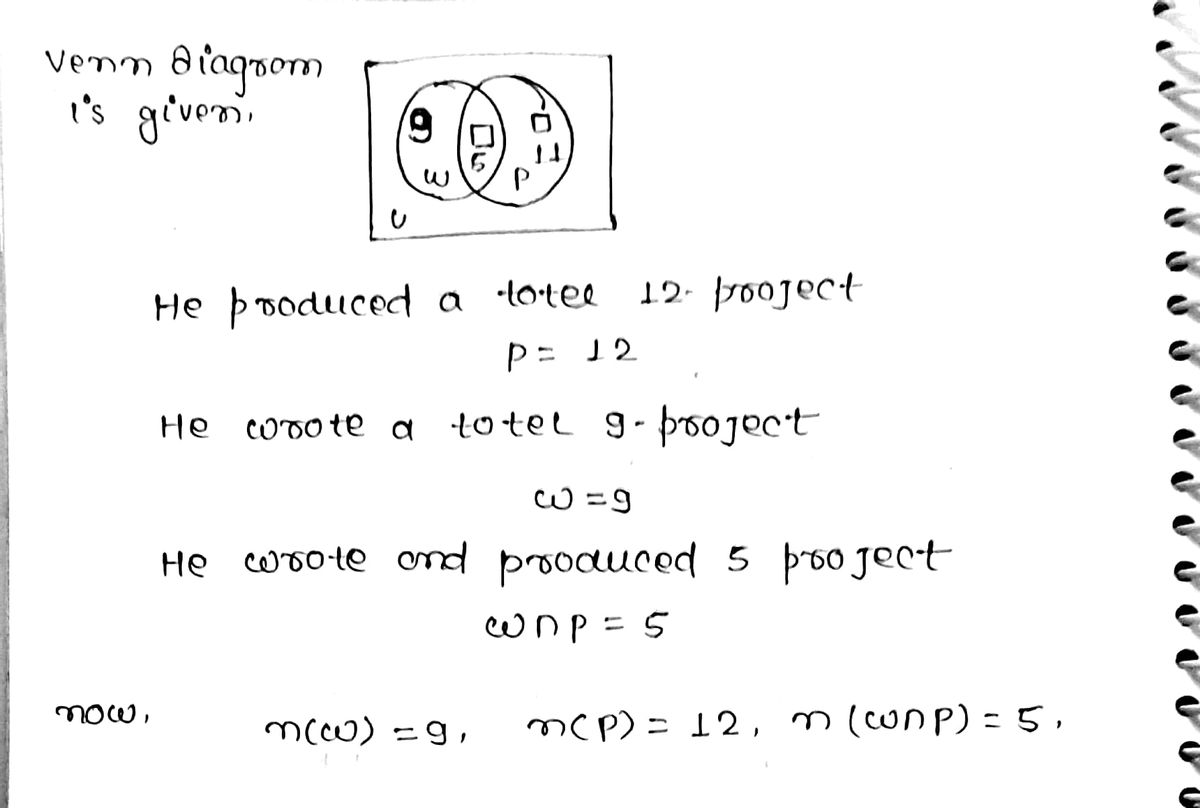A bass guitarist worked on 16 music projects last year. He wrote and produced 5 projects. He wrote a total of 9 projects. He produced a total of 12 projects. Use a Venn diagram to determine (a) many projects he wrote but did not produce, and (b) how many projects he produced but did not write. Complete the Venn diagram. Let W be the set of projects the bass guitarist wrote and P be the set of projects he produced (a) How many projects did he write but not produce? project(s) (Type a whole number.) (b) How many projects did he produce but not write? project(s) (Type a whole number.)
A bass guitarist worked on 16 music projects last year. He wrote and produced 5 projects. He wrote a total of 9 projects. He produced a total of 12 projects. Use a Venn diagram to determine (a) many projects he wrote but did not produce, and (b) how many projects he produced but did not write. Complete the Venn diagram. Let W be the set of projects the bass guitarist wrote and P be the set of projects he produced (a) How many projects did he write but not produce? project(s) (Type a whole number.) (b) How many projects did he produce but not write? project(s) (Type a whole number.)
Glencoe Algebra 1, Student Edition, 9780079039897, 0079039898, 2018
18th Edition
ISBN:9780079039897
Author:Carter
Publisher:Carter
Chapter1: Expressions And Functions
Section1.4: Distributive Property
Problem 11PPS
Related questions
Question
100%

Transcribed Image Text:A bass guitarist worked on 16 music projects last year. He wrote and produced 5 projects. He wrote a total of 9 projects. He produced a total of 12 projects. Use a Venn diagram to determine (a) how
many projects he wrote but did not produce, and (b) how many projects he produced but did not write.
Complete the Venn diagram. Let W be the set of projects the bass guitarist wrote and P be the set of projects he produced
U
(a) How many projects did he write but not produce?
project(s)
(Type a whole number.)
(b) How many projects did he produce but not write?
project(s)
(Type a whole number.)

Transcribed Image Text:For P = {9, 12, 14, 15}, Q = {2, 7, 13}, and R = {3, 7, 10, 13}, find PU (QN R).
The answer is
(Use a comma to separate answers as needed.)
Expert Solution
Step 1

Trending now
This is a popular solution!
Step by step
Solved in 3 steps with 3 images

Recommended textbooks for you

Glencoe Algebra 1, Student Edition, 9780079039897…
Algebra
ISBN:
9780079039897
Author:
Carter
Publisher:
McGraw Hill

Algebra and Trigonometry (MindTap Course List)
Algebra
ISBN:
9781305071742
Author:
James Stewart, Lothar Redlin, Saleem Watson
Publisher:
Cengage Learning

College Algebra
Algebra
ISBN:
9781305115545
Author:
James Stewart, Lothar Redlin, Saleem Watson
Publisher:
Cengage Learning

Glencoe Algebra 1, Student Edition, 9780079039897…
Algebra
ISBN:
9780079039897
Author:
Carter
Publisher:
McGraw Hill

Algebra and Trigonometry (MindTap Course List)
Algebra
ISBN:
9781305071742
Author:
James Stewart, Lothar Redlin, Saleem Watson
Publisher:
Cengage Learning

College Algebra
Algebra
ISBN:
9781305115545
Author:
James Stewart, Lothar Redlin, Saleem Watson
Publisher:
Cengage Learning

Algebra: Structure And Method, Book 1
Algebra
ISBN:
9780395977224
Author:
Richard G. Brown, Mary P. Dolciani, Robert H. Sorgenfrey, William L. Cole
Publisher:
McDougal Littell

College Algebra (MindTap Course List)
Algebra
ISBN:
9781305652231
Author:
R. David Gustafson, Jeff Hughes
Publisher:
Cengage Learning

Holt Mcdougal Larson Pre-algebra: Student Edition…
Algebra
ISBN:
9780547587776
Author:
HOLT MCDOUGAL
Publisher:
HOLT MCDOUGAL